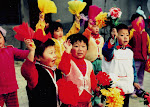 |
| A bell at the Big Bell Temple |
If you're going to be in Beijing for more than a few days and like off-the-beaten path attractions, as I do, the Beijing Museum Pass could be just what you're looking for.
Major international cities like Seattle and Paris have city passes that are good for one to three days of admissions to a city's major attractions. To get your money's worth, you have to rush around to a lot of museums.
Not so with the Beijing Museum Pass. You've got a whole year to use it. And, unlike the other city passes where each person has to buy one, the Beijing pass is good for free or discounted admissions for one, two or more people.
The 2012 pass covers 115 museums, art galleries and other tourist attractions; you can even use it to go strawberry picking.
The pass only makes sense if you're going to be in Beijing a week or longer, or are making a return visit to the Chinese capital. If you're on your first visit to Beijing, you need to see the major attractions: Forbidden City, Tiananmen Square, Summer Palace, Great Wall, Temple of Heaven, etc. The pass does not cover these major sites. Instead, it covers admissions to lesser known sites, some of which are among my favorites in Beijing, such as the White Dagoba Temple at Beihai Park, the Ancient Bell Museum at the Great Bell Temple, Drum and Bell towers, and Soong Ching Ling House.
Some museums allow free admission for up to two people, others allow half-price admission or similar discounts. The packet also comes with tickets to museums that are free to begin with, but having this ticket means you don't have to stand in line to get the free tickets.
The
Beijing Museum Pass for 2012 costs 120 yuan (approximately $19) and, sponsors say, represents a savings of 2,500 yuan (approximately $400) if you were to visit each museum in the program. Of course, only a tiny percent of people will actually do that. But two people only have to visit five or six museums for the pass to pay for itself.
The pass, known as bowuguan, can be purchased at post offices in Beijing.
Pair the museum pass with an yikatong, available at subway stations, and you're all set to see the sights of Beijing. This is a pass that allows you to move around on Beijing's subway and bus systems. You don't save any money on subway rides, but do get a slight discount on bus rides. The main benefit to the yikatong is you don't have to stand in line to buy subway tickets or worry about how much bus fare will be -- Beijing buses charge fares based on distance. We've used yikatongs on our last two trips to Beijing, and they are really convenient.
Are you going to China?
If a trip to China is in your travel plans, please check out my website,
Cheryl's China, and feel free to
email me if you have any questions about travel in China, especially Beijing.
 People who were born in a Year of the Dragon will have good luck this year. It doesn't mean they won't have good luck, in say the Year of Pig, but legend says their luck will be even better in years of their birth animal.
People who were born in a Year of the Dragon will have good luck this year. It doesn't mean they won't have good luck, in say the Year of Pig, but legend says their luck will be even better in years of their birth animal.




